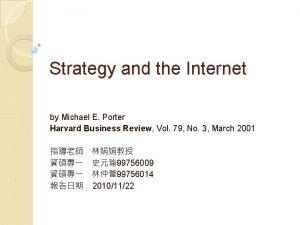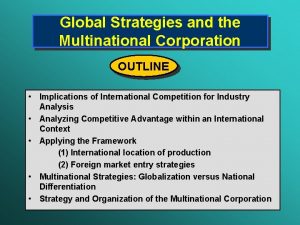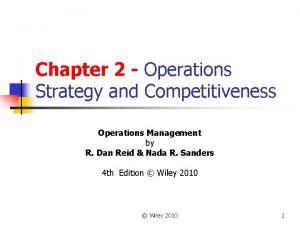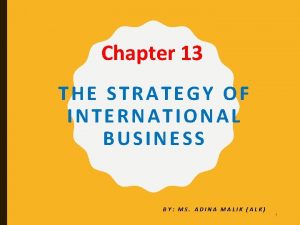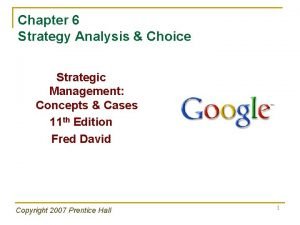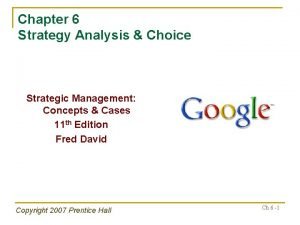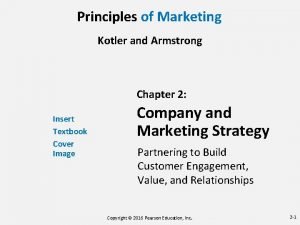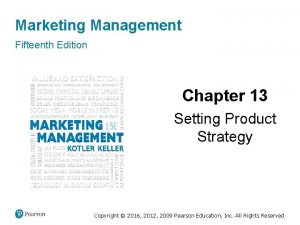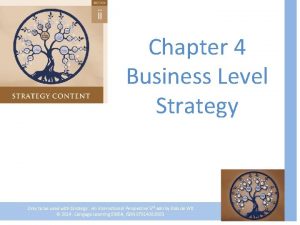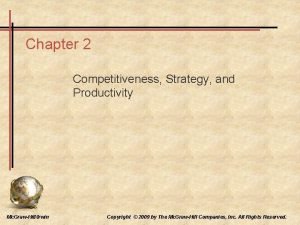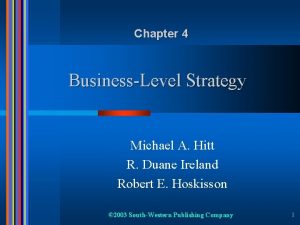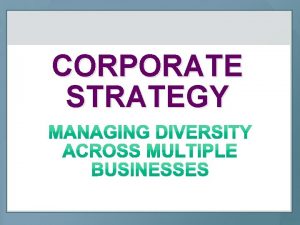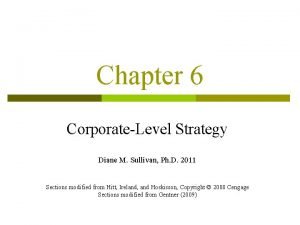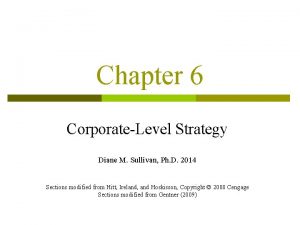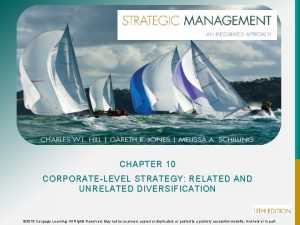Chapter 6 CorporateLevel Strategy Michael A Hitt R


































- Slides: 34

Chapter 6 Corporate-Level Strategy Michael A. Hitt R. Duane Ireland Robert E. Hoskisson © 2003 Southwestern Publishing Company 1

Strategic Inputs The Strategic Management Process Chapter 2 The External Environment Strategic Intent Strategic Mission Chapter 3 The Internal Environment Strategy Implementation Strategic Outcomes Strategic Actions Strategy Formulation Chapter 5 Chapter 4 Competitive Rivalry Business-Level and Competitive Strategy Dynamics Chapter 6 Corporate. Level Strategy Chapter 10 Corporate Governance Chapter 11 Organizational Structure and Controls Chapter 12 Strategic Leadership Chapter 13 Strategic Entrepreneurship Strategic Competitiveness Above-Average Returns Feedback 2

Two Levels of Strategy A diversified company has two levels of strategy 1. Business-Level Strategy (Competitive Strategy) How to create competitive advantage in each business in which the company competes - low cost - differentiation - focused low cost - focused differentiation - integrated low cost/ differentiation 2. Corporate-Level Strategy (Company-wide Strategy) How to create value for the corporation as a whole 3

Key Questions in Corporate Strategy 1. What businesses should the corporation be in? 2. How should the corporate office manage the array of business units? Corporate Strategy is what makes the corporate whole add up to more than the sum of its business unit parts 4

Levels and Types of Diversification Low Levels of Diversification Single Business > 95% of business from a single business unit Dominant Business Between 70 and 95% of business from a single business unit 5

Levels and Types of Diversification Moderate to High Levels of Diversification Related Constrained <70% of revenues from dominant business; all businesses share product, technological and distribution linkages 6

Levels and Types of Diversification Moderate to High Levels of Diversification Related Linked (Mixed) < 70% of revenues from dominant business, and only limited links exist 7

Levels and Types of Diversification Very High Levels of Diversification Unrelated < 70% of revenue comes from the dominant business, and there are no common links between businesses 8

Reasons for Diversification Incentives Resources Reasons to Enhance Strategic Competitiveness • Economies of scope • Market power • Financial economics Managerial Motives 9

Reasons for Diversification Incentives Resources Managerial Motives Incentives with Neutral Effects on Strategic Competitiveness • • • Anti-trust regulation Tax laws Low performance Uncertain future cash flows Firm risk reduction 10

Reasons for Diversification Incentives Resources Managerial Motives Resources with varying effects on value creation and strategic competitiveness • Tangible resources - financial resources - physical assets • Intangible resources - tacit knowledge - customer relations - image and reputation 11

Reasons for Diversification Incentives Resources Managerial Motives (Value Reduction) • Diversifying managerial employment risk • Increasing managerial compensation Managerial Motives 12

Value-creating Strategies of Diversification: Sharing: Operational Relatedness Between Businesses Operational and Corporate Readiness High Related Constrained Diversification Vertical Integration (Market Power) Low Unrelated Diversification (Financial Economies) Both Operational and Corporate Relatedness (Rare Capability and can Create Diseconomies of Scope) Related Linked Diversification (Economies of Scope) Low High Corporate Readiness: Transferring Skills into 13 Businesses Through Corporate Headquarters

Adding Value by Diversification most effectively adds value by either of two mechanisms: – Economies of scope: cost savings attributed to transferring the capabilities and competencies developed in one business to a new business – Market power: when a firm is able to sell its products above the existing competitive level or reduce the costs of its primary and support activities below the competitive level, or both 14

Alternative Diversification Strategies Related Diversification Strategies – sharing activities – transferring core competencies Unrelated Diversification Strategies – efficient internal capital market allocation – restructuring 15

Alternative Diversification Strategies Related Diversification Strategies – sharing activities 16

Sharing Activities: Key Characteristics Sharing activities often lowers costs or raises differentiation l Sharing activities can lower costs if it: l – – – achieves economies of scale boosts efficiency of utilization helps move more rapidly down the Learning Curve Sharing activities can enhance potential for or reduce the cost of differentiation l Must involve activities that are crucial to competitive advantage l 17

Sharing Activities: Assumptions Strong sense of corporate identity l Clear corporate mission that emphasizes the importance of integrating business units l Incentive system that rewards more than just business unit performance l 18

Alternative Diversification Strategies Related Diversification Strategies – sharing activities – transferring core competencies 19

Transferring Core Competencies: Key Characteristics Exploits interrelationships among divisions l Start with value chain analysis l – identify ability to transfer skills or expertise among similar value chains – exploit ability to transfer activities 20

Transferring Core Competencies: Assumptions l Transferring core competencies leads to competitive advantage only if the similarities among business units meet the following conditions: – activities involved in the businesses are similar enough that sharing expertise is meaningful – transfer of skills involves activities which are important to competitive advantage – the skills transferred represent significant sources of competitive advantage for the receiving unit 21

Alternative Diversification Strategies Related Diversification Strategies – sharing activities – transferring core competencies Unrelated Diversification Strategies – efficient internal capital market allocation 22

Efficient Internal Capital Market Allocation: Key Characteristics l Firms pursuing this strategy frequently diversify by acquisition: – – acquire sound, attractive companies acquired units are autonomous acquiring corporation supplies needed capital portfolio managers transfer resources from units that generate cash to those with high growth potential and substantial cash needs – add professional management & control to sub -units – sub-unit managers compensation based on unit results 23

Efficient Internal Capital Market Allocation: Assumptions Managers have more detailed knowledge of firm relative to outside investors l Firm need not risk competitive edge by disclosing sensitive competitive information to investors l Firm can reduce risk by allocating resources among diversified businesses, although shareholders can generally diversify more economically on their own l 24

Alternative Diversification Strategies Related Diversification Strategies – sharing activities – transferring core competencies Unrelated Diversification Strategies – efficient internal capital market allocation – restructuring 25

Restructuring: Key Characteristics Seek out undeveloped, sick or threatened organizations or industries l Parent company (acquirer) intervenes and frequently: l – – changes sub-unit management team shifts strategy infuses firm with new technology enhances discipline by changing control systems – divests part of firm – makes additional acquisitions to achieve critical mass 26

Restructuring: Key Characteristics l Frequently sell unit after making one-time changes since parent no longer adds value to ongoing operations 27

Restructuring: Assumptions Requires keen management insight in selecting firms with depressed values or unforeseen potential l Must do more than restructure companies l Need to initiate restructuring of industries to create a more attractive environment l 28

Incentives to Diversify External Incentives: Relaxation of anti-trust regulation allows more related acquisitions than in the past l Before 1986, higher taxes on dividends favored spending retained earnings on acquisitions l After 1986, firms made fewer acquisitions with retained earnings, shifting to the use of debt to take advantage of tax deductible interest payments l 29

Incentives to Diversify Internal Incentives: Poor performance may lead some firms to diversify to attempt to achieve better returns l Firms may diversify to balance uncertain future cash flows l Firms may diversify into different businesses in order to reduce risk l 30

Resources and Diversification Besides strong incentives, firms are more likely to diversify if they have the resources to do so l Value creation is determined more by appropriate use of resources than incentives to diversify l 31

Managerial Motives to Diversify Managers have motives to diversify – diversification increases size; size is associated with executive compensation – diversification reduces employment risk – effective governance mechanisms may restrict such motives 32

Performance Relationship Between Diversification and Performance Dominant Business Related Constrained Level of Diversification Unrelated Business 33

Relationship Between Firm Performance and Diversification Incentives Resources Managerial Motives Capital Market Intervention and the Market for Managerial Talent Diversification Strategy Internal Governance Firm Performance Strategy Implementation 34
 Carrie cullen hitt
Carrie cullen hitt Kom hitt
Kom hitt Internet technology
Internet technology Porter strategy and the internet
Porter strategy and the internet Business strategy vs corporate strategy
Business strategy vs corporate strategy Firms that emphasize global integration make and sell
Firms that emphasize global integration make and sell Chase strategy adalah
Chase strategy adalah Multidomestic international strategy
Multidomestic international strategy Aligning hr strategy with business strategy
Aligning hr strategy with business strategy Site:slidetodoc.com
Site:slidetodoc.com The managerial process of crafting and executing strategy
The managerial process of crafting and executing strategy The plan of action that prescribes resource allocation
The plan of action that prescribes resource allocation Listening strategies definition
Listening strategies definition Parenting strategy in strategic management
Parenting strategy in strategic management International or multinational
International or multinational Operations strategy and competitiveness
Operations strategy and competitiveness Operations management chapter 2
Operations management chapter 2 The strategy of international business chapter 13
The strategy of international business chapter 13 Chapter 13 game theory and competitive strategy
Chapter 13 game theory and competitive strategy Chapter 12 planning your tax strategy
Chapter 12 planning your tax strategy Chapter 11 the price strategy worksheet answers
Chapter 11 the price strategy worksheet answers Chapter 7 marketing
Chapter 7 marketing Chapter 6 strategy analysis and choice
Chapter 6 strategy analysis and choice Wt strategies
Wt strategies Chapter 6 strategy analysis and choice
Chapter 6 strategy analysis and choice Chapter 6 strategy analysis and choice
Chapter 6 strategy analysis and choice Marketing mix kotler and armstrong
Marketing mix kotler and armstrong Chapter 13 setting product strategy ppt
Chapter 13 setting product strategy ppt Matching stage of strategy formulation framework
Matching stage of strategy formulation framework Chapter 4 business level strategy
Chapter 4 business level strategy Unitless measure of productivity
Unitless measure of productivity Why is productivity important
Why is productivity important Blue ocean strategy chapter 2 summary
Blue ocean strategy chapter 2 summary Operation strategy in a global environment
Operation strategy in a global environment Company and marketing strategy chapter 2
Company and marketing strategy chapter 2



